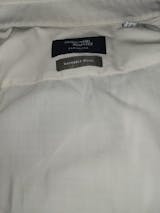U For Umbrellas and Underwear
Umbrellas
You may wonder why an umbrella should be part of the Ivy wardrobe but to complete that enduring look, if those grey clouds threaten rain, a decent umbrella is essential - just in case. My grandfather, a very stylish man and a kind of sartorial hero of mine, albeit from another era, would never leave home without his ‘brolly’ or ‘gamp’ as he called it.
A gamp is essentially a large umbrella, but this word is thought to have made its debut in 1855. The word derives from Charles Dicken’s ‘Martin Chuzzlewit novel (1843/44) in which his character Sara Gamp often carried a large cotton umbrella. From this people began calling the umbrella a gamp although the word is not commonly used now. The origin of the word ‘brolly’ is an alteration of the word umbrella dating back to around 1870/1875. This word is one that we commonly use today, with many brands marketing the product as this.
A good umbrella is an accessory that is comfortable to hold and is smooth to operate as well as keeping you dry or indeed, to protect from harsh sunlight. I buy my umbrellas from the London based umbrella maker James Smith, established in 1830 and still a thriving business today.
In 1851 Samuel Fox invented the lightweight steel frame and umbrellas, now easily available grew in popularity. James Smith was one of the first to use fox frames and his business grew to the point when he had to move to larger premises at 53, New Oxford Street, where the shop, almost unaltered, is a perfect example of a Victorian shop front design. It remains as one of the landmarks of Central London and is commonly referred to as ‘The umbrella shop’ by black cab drivers and locals alike.
Underwear
Tastes in men’s underwear have diversified in recent years, with briefs sharing drawer space with boxers, in a range of colours and patterns. I may be old-fashioned but there is nothing more comfortable under my Levis or
chino pants than a pair of fine cotton boxers. I’ve tried slimmer briefs but always come back to the trusty boxer shorts. They took their name when heavyweight fighters Jim Corbett and Bob Fitzsimmons abandoned traditional boxers’ tights for trunks.
Did you know that Winston Churchill liked to wear pale pink silk underwear? A fact that seems one of ultimate luxury for a big man. Jockey briefs were launched in 1934 after a company executive took inspiration from men
wearing bikinis on the Riviera. In the Eighties boxer shorts were popularly worn in novelty prints as shorts and beachwear. Today to accommodate body-conscious streamlining underwear has generally shrunk. Boxers waists
have dropped slightly and legs are often slit but for me they work best with my Ivy clothes.
A successful wardrobe needs to be built upon a few basics and what could be more basic than a plain white T-shirt. The simple T-shirt began it’s fashion life covertly, as a garment to be hidden under your button-down shirt. It has, however, emerged as an overt expression of personel style, carrying both printed messages and also the more subtle, sensual message of one’s body. A soft cotton white T-shirt, though anonymous is an essential part of the Ivy look.
The sleeveless athletic shirt of the 1930s was adapted from the top half of the tank swimsuit worn by American men in the early years of the 20th century. It was replaced in the 1940s by the T-shirt with short sleeves worn by the servicemen of World War II. By the fifties, the T-shirt had become sportswear, as young men took their style cues from movie idols such as James Dean and Marlon Brando, who wore them with jeans. Now the T-shirt comes in all fabrics, weights and textures making the simple undershirt a unique creature.
Written and illustrated by Graham Marsh
Illustrations: Copyright Graham Marsh
Next up is the letter V
About Graham Marsh
Graham Marsh is an art director, illustrator and writer. He has written and art directed many ground-breaking visual books including The Cover Art of Blue Note Records, volumes 1 and 2, East Coasting and California Cool. He has co-authored and art directed Denim: From Cowboys to Catwalks and a series of books with Tony Nourm and on movie posters. More recent books are The Ivy Look, Hollywood and the Ivy Look, Jazz Festival, The Beat Scene, French New Wave: A Revolution in Design and a 50th Anniversary volume on Woodstock plus a book on the early years of Ronnie Scott’s Jazz Club. He is author and illustrator of a children’s book called Max and the Lost Note. Marsh’s illustrations have appeared in magazines, newspapers and on many CD and album covers. He has contributed to numerous publications including Country Life and Financial Times.



